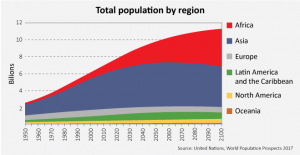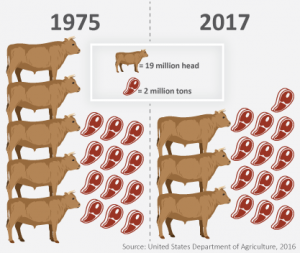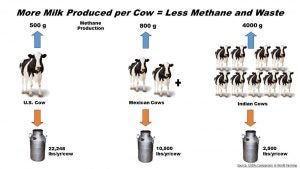When fewer animals = more protein
It’s a proverbial win-win situation. Find a way to get more protein from fewer animals. It would make us better positioned to feed a global population that will total 10 billion by 2050, at the same time avoiding or at least limiting the deforestation of lands to create farmland and reducing greenhouse gas emissions.
It’s not a dream. It’s an achievable goal, especially if we can apply the knowledge and expertise of developed countries to those that are developing. The latter are currently producing less protein from more animals. In addition, they stand to experience the greatest population growth in the next decades, making the need for efficiency critical to sustaining the planet’s life and its environment.

History gives us reason to be optimistic. Great progress has already been made to improve the environmental efficiency of cattle production in the developed world. According to the USDA, the total number of beef cattle in the U.S. peaked in 1975 with a population of 132 million head. Since then, the population has steadily declined, with the 2017 population at approximately 94 million. However, the amount of beef between 1975 and today has remained stable.
The record cattle population of 1975 produced 24 million tons of beef, while the 2017 population, with 38 million fewer head, produced 26 million tons of beef (USDA, 2016). This sustained trend means the beef industry has been able to produce much more beef per animal unit, thereby decreasing the amount of feed, animal waste and enteric emissions needed to produce each product of beef by diluting out animal maintenance costs (reducing the proportion of feedstuffs required to keep the animal alive relative to the total feedstuffs consumed).

We’ve achieved the same results with dairy production. For example, today one California cow produces the same amount of milk as two of her peers in Mexico and nine of her peers in India. Capper et. al. pointed out that compared to 1944, the 2007 U.S. dairy industry reduced its greenhouse gas emissions per unit of milk by 63%. This reduction was achieved through improved nutrition, management, genetics, etc., born through scientific research that has led to dramatic improvements in milk production per cow. It’s worth pointing out that even more could be achieved in the United States and other developed nations by advancing genetics, nutrition, animal health, etc., to dilute maintenance costs further to lower the life cycle GHGs per unit of beef or dairy product.

Intensification of livestock production provides large opportunities for climate change mitigation and can reduce deforestation, thus becoming a long-term solution to more sustainable livestock production. It also gives us the most efficient way possible of meeting an unprecedented need for protein as part of the 2050 challenge.
-Frank Mitloehner (@GHGGuru)